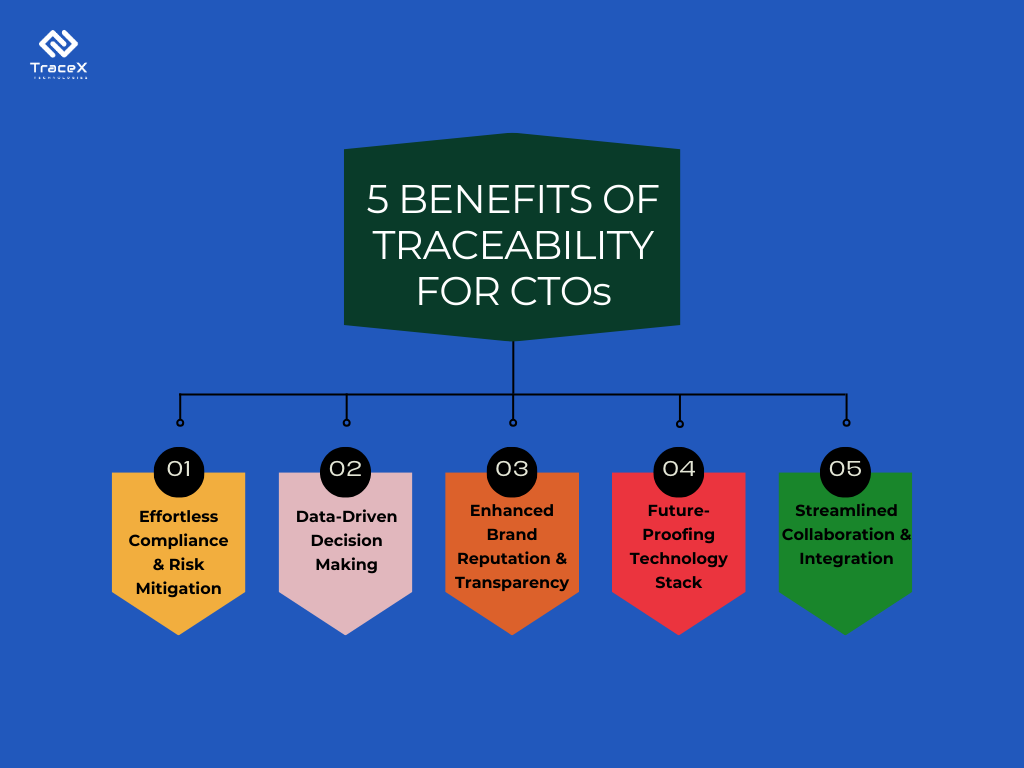Contact: +91 99725 24322 |
Menu
Menu
Quick summary: Discover how CTOs can drive digital transformation with traceability solutions. Learn how leveraging blockchain, IoT, and AI technologies can enhance transparency, improve operational efficiency, and ensure regulatory compliance. Transform your supply chain and gain a competitive edge with innovative traceability solutions.

In today’s fast-paced digital landscape, Chief Technology Officers (CTOs) play a pivotal role in steering companies toward innovation and efficiency. Traceability solutions not only streamline processes but also drive digital transformation. By implementing these advanced technologies, CTOs can enhance operational transparency, ensure compliance, and improve overall supply chain management.
Successful organizations are embracing digital transformation, leveraging technology to boost efficiency, enhance customer experiences, and gain a competitive edge. This shift places CTOs at the forefront of driving change within their companies, making them pivotal in navigating and implementing technological advancements.
Digital transformation is crucial for businesses to remain competitive and responsive in today’s fast-paced, technology-driven environment. It involves integrating digital technology into all areas of a business, fundamentally changing how operations are conducted and how value is delivered to customers.
1. Improved Efficiency: Automation and digital tools streamline processes, reducing manual efforts and errors.
2. Enhanced Customer Experience: Personalization and data analytics enable better understanding and meeting customer needs.
3. Agility and Innovation: Digital transformation allows businesses to quickly adapt to market changes and innovate.
4. Data-Driven Decisions: Leveraging big data and analytics for informed decision-making.
5. Cost Reduction: Streamlining processes and reducing overhead costs.
Digital transformation is not just a technological upgrade but a cultural shift that encourages continuous improvement and agility, crucial for staying relevant and competitive in today’s business landscape.
Traceability solutions involve tracking the movement of products through each stage of the supply chain, from production to consumption. They ensure transparency, improve quality control, and help in compliance with regulations.
Overview of Technologies Used in Traceability:
By integrating these technologies, traceability solutions enhance supply chain transparency, improve operational efficiency, and ensure regulatory compliance, making them a critical component of digital transformation strategies.
CTOs must define and articulate a clear vision for digital transformation that aligns with the company’s overall strategic goals. This involves understanding emerging technologies and their potential impact on the business. Ensuring that traceability initiatives support key business objectives such as improving supply chain transparency, enhancing product quality, and ensuring regulatory compliance.
CTOs should foster an environment that encourages creativity, experimentation, and the adoption of new ideas. This can be achieved by supporting employee training, creating innovation labs, and incentivizing innovative thinking. CTOs play a crucial role in advocating for and implementing cutting-edge technologies such as blockchain, IoT, and AI. They must also manage change effectively, ensuring that the organization is ready to embrace new processes and tools.
CTOs must ensure that new traceability technologies integrate seamlessly with existing IT infrastructure. This includes overseeing data integration, system interoperability, and maintaining data integrity across platforms. CTOs should focus on creating a cohesive digital ecosystem where data flows effortlessly between departments. This ensures that all stakeholders have access to accurate, real-time information, enhancing decision-making and operational efficiency.
By fulfilling these roles, CTOs can effectively drive digital transformation, leveraging traceability solutions to boost efficiency, transparency, and innovation within their organizations.
As a CTO, implementing a traceability solution can be a complex but rewarding task.
1. Define Your Traceability Goals:
Start by understanding the specific needs of your business. Are you looking to comply with regulations, enhance brand transparency, or optimize your supply chain? Clearly define your key objectives. Do you want to track products from farm to fork, or focus on specific stages like processing or distribution? Collaborate with relevant departments like procurement, marketing, and operations to ensure everyone is on board with traceability goals.
2. Evaluate Traceability Technologies:
Explore different traceability technologies like blockchain, QR codes, RFID, and sensor technology. Evaluate each option based on factors like scalability, security, cost, and ease of integration with your existing systems. Consider running pilot projects with a few technologies to test their effectiveness and identify the best fit for your needs.
3. Develop Your Traceability Strategy:
Determine what data you will collect at each stage of the supply chain. This might include origin information, processing details, and transportation data. Establish data standards to ensure consistency and facilitate seamless information exchange across your supply chain partners. Plan for secure data storage, access control, and procedures for data analysis and reporting.
4. Implementing Traceability Solutions:
Choose a traceability solution that aligns with your technical infrastructure and budget. Consider scalability as your business grows. Integrate the chosen solution with your existing enterprise resource planning (ERP) systems and other relevant software. Train all stakeholders involved in the supply chain on using the traceability system, ensuring data accuracy and system adoption.
Prioritize data security and ensure your chosen solution complies with relevant data privacy regulations. Balance the cost of implementing and maintaining a traceability solution with the long-term benefits it offers. Choose a solution that can scale as your business grows and your traceability needs evolve.

Here’s how TraceX’s blockchain traceability solutions specifically address the points raised in the previous section on steps for CTOs to implement traceability solutions:
In conclusion, TraceX’s blockchain traceability solutions are designed to address the key considerations for CTOs implementing traceability. Their focus on security, scalability, user-friendliness, and industry-specific features make them a strong contender for organic food brands seeking to leverage the power of traceability.
Green Earth Fresh Produce, a contract farming company implemented TraceX solutions to enhance the traceability and transparency of their lettuce supply chain for Vista Foods that supplies iceberg lettuce to McDonald’s. By integrating blockchain technology, they achieved real-time tracking from farm to fork. This allowed GEFP to ensure the quality and safety of the lettuce, monitor compliance with food safety standards, and swiftly address any issues that arose. As a result, they improved operational efficiency, reduced waste, and enhanced consumer trust in the quality of produce for Vista Foods.
Chief Technology Officers (CTOs) are the architects of digital transformation, and traceability solutions empower them to meet these demands while ensuring ironclad compliance with ever-changing regulations.
The regulatory landscape is constantly shifting. Traceability solutions help CTOs stay updated on emerging regulations and adapt their systems accordingly. This ensures long-term compliance and avoids costly penalties. Traceability ensures adherence to regulations while fostering transparency and brand trust. This creates a win-win for businesses, consumers, and regulatory bodies alike.
As digital transformation continues to reshape industries, CTOs play a pivotal role in leveraging traceability solutions to drive this change. By adopting advanced technologies such as blockchain, IoT, and AI, CTOs can enhance transparency, improve operational efficiency, and build consumer trust. These solutions not only ensure regulatory compliance but also provide a competitive edge in a rapidly evolving market. Embracing traceability is not just about keeping pace with technological advancements; it’s about pioneering a future where supply chain integrity and sustainability are at the forefront. With the right strategic vision and innovative approach, CTOs can lead their organizations to new heights of success in the digital era.
